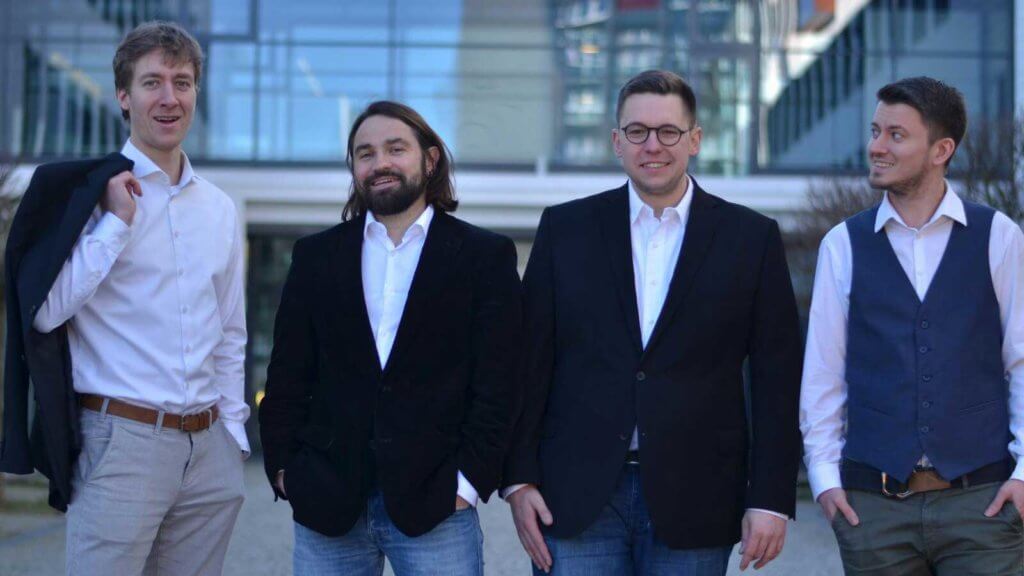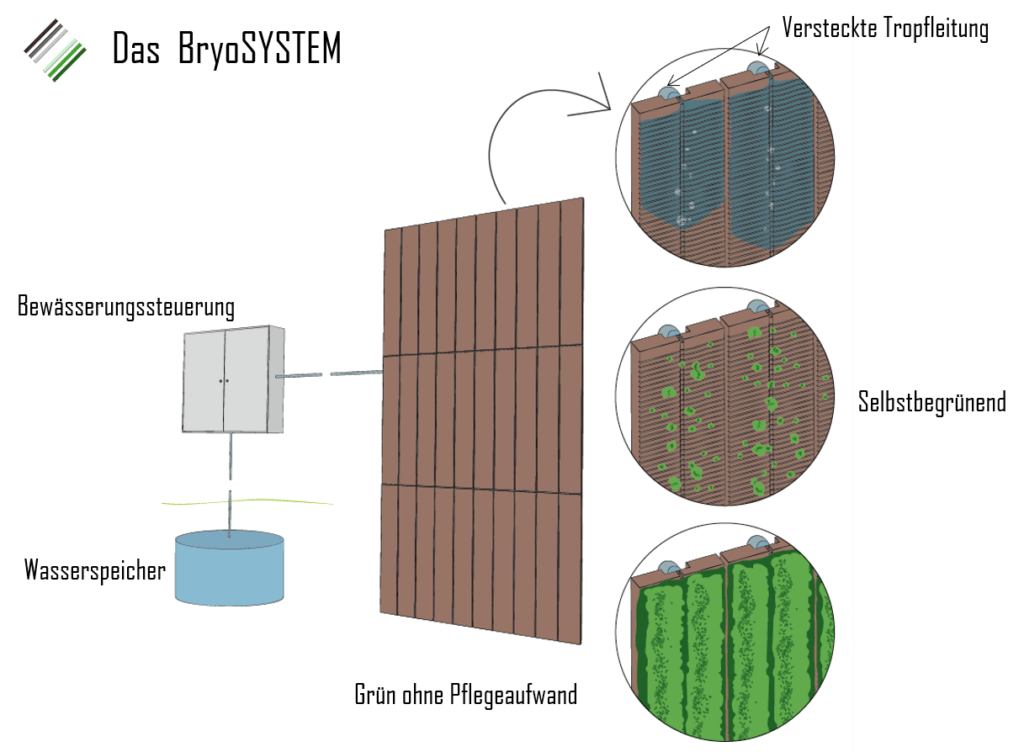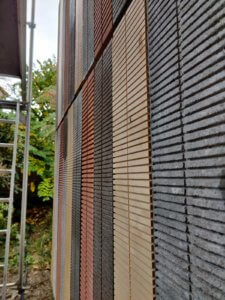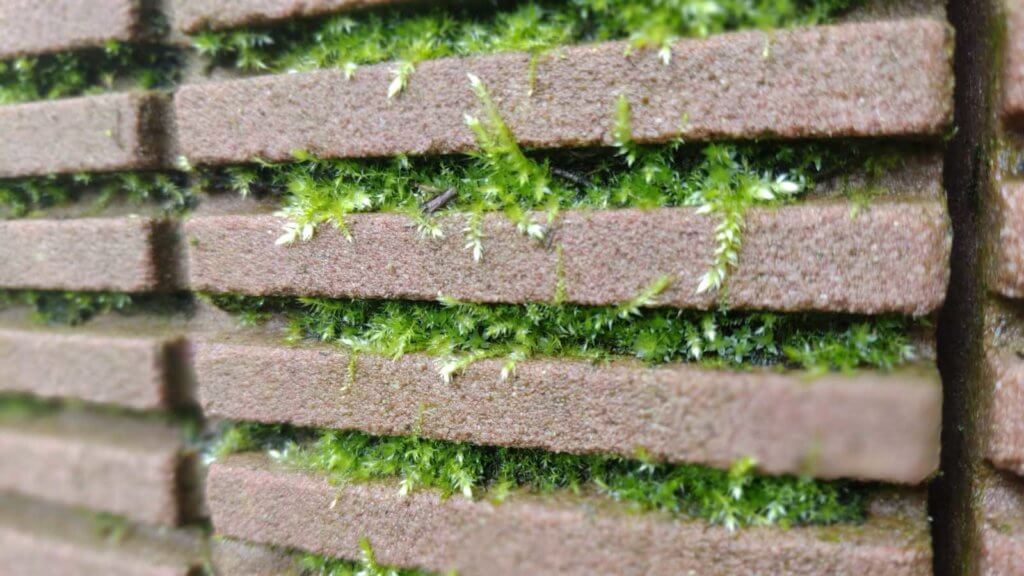"We want to design buildings close to nature in a completely new way"
Judith Hillen
House facades on which plants grow are not only good for the environment, but also for the people in the city. Dr. Tobias Graf, founder and CEO of Artificial Ecosystems, is convinced of this. His startup, based in Kaiserslautern, which is part of the 5-HT network, develops innovative solutions for green building facades. This involves the use of mosses that require little maintenance and are supplied with the help of an algorithmically controlled irrigation cycle. In an interview with 5-HT, Tobias Graf explains the advantages of green building facades and what makes Artificial Ecosystems special compared to other providers of green facade solutions.
 Martin Hamp, Dr. Tobias Graf, Björn Stichler, Alexander Pohl (f.l.t.r.) from Artificial Ecosystems
Martin Hamp, Dr. Tobias Graf, Björn Stichler, Alexander Pohl (f.l.t.r.) from Artificial EcosystemsWhy has Artificial Ecosystems dedicated itself to the topic of facade greening?
Facade greening brings a whole host of advantages for buildings and cities when it comes to issues such as energy efficiency and thermal insulation, but also oxygen production and fine material binding. In addition, green facades have a recreational effect on people and enhance the cityscape. With Artificial Ecosystems we have therefore set ourselves the goal of developing façade greening systems that make both ecological and economic sense. In this way, we want to enhance not only building facades, but also other areas of public life such as bus stops or train stations through greening.

How does BryoSYSTEM, your first solution for facade greening, work?
The BryoSYSTEM is a self greening ventilated curtain wall. Behind the component, which can be attached to facades, there is a hidden irrigation circuit that is controlled by an algorithm, so that mosses settle on the surface all by themselves. Behind this is an IoT technology that uses sensors to detect the actual state of the wall. Meteorological data are determined and evaluated. On this basis, the plants can be watered and fertilized as needed.
 Das BryoSYSTEM
Das BryoSYSTEMWhat are the biggest challenges in the development of systems for facade greening?
Especially the technology behind our system is very complex. In addition, facade greening requires a lot of know-how in civil engineering. For example, you have to make sure that the statics of the facade wall are not affected, that no moisture penetrates the masonry and that the supply of rainwater is guaranteed. The selection of suitable plants is also highly complex. For plants, vertical surfaces are basically hostile environments, as these are extreme locations with strong temperature fluctuations. For this reason, it is important to select plants that can cope well with these changing conditions.

How does the BryoSYSTEM differ from other solutions for facade greening?
The BryoSYSTEM requires very little maintenance, so that immense costs can be saved. Other systems for facade greening cause high running costs for maintenance year after year, for example for weed removal or replanting. Our great advantage is that we use mosses that prevent other plants from growing in their vicinity, so there is no need for weeding. Furthermore, mosses do not need pruning and do not need to be fertilized. We also follow a plant-ecological rather than a horticultural approach. Previous systems have often originated in horticulture: The plants are elaborately cultivated in greenhouses and then used in facade greening. In contrast, we look at which plants would also grow by themselves in the city from an ecological perspective, so that they require less care in facade systems. In this way we want to make facade greening more affordable for the future.
 Detail view BryoSYSTEM with moss
Detail view BryoSYSTEM with mossHow was Artificial Ecosystems founded?
The idea was originally born during my biology studies, during which I learned a lot about different mosses while specializing in plant ecology. Thereupon I did my doctorate at the TU Munich in the field of plant nutrition and irrigation. This led to the idea for Artificial Ecosystems about three years ago. From that time on, I started looking for like-minded people from other disciplines who could complement my biological knowledge. The founding team is therefore very interdisciplinary: Martin Hamp studied civil engineering, Björn Stichler brings the necessary IT expertise for the development of our IoT systems, and Alexander Pohl takes care of the business management part. In the first year in which we were supported by the EXIST start-up grant, we used the time to strengthen our business model. The GmbH was finally founded in February this year.
What are the next goals for Artificial Ecosystems?
We are currently working on two projects that are to be realized in the southwest region at the beginning of 2021. We are also looking for new partners for pilot projects. We are also experimenting with other plants that could be used for facade systems, for example herbaceous perennials or smaller trees. If we bring flowering plants into a vertical position, we can simultaneously colonize the corresponding insects and thus create small, self-contained ecological cycles in the middle of the city.
What do you expect from being part of the 5-HT Digital Hub?
We would be pleased if the topic of facade and urban greening would receive more attention in the network of 5-HT. Although many people can already imagine what it is like, we experience time and again that even architects often don't know how complex the topic is. Since the Corona crisis has slowed us down in our current financing round, we are also open to investments and participations. In addition, we are looking for ambitious city greeners from the fields of IT, civil engineering, horticulture and biology to join our team. Apart from that, we are always interested in partnerships with companies or startups that want to create synergies with us.
Where do you see yourselves in five years?
In five years, we want to have three to five established systems on the market with which we will advance urban greening and building greenery. In addition, we want to have completed a number of successful reference projects by then and generate enough revenue so that we can help to shape a more sustainable and liveable city life with our team and our products. With our solutions, we want to give building owners and architects the opportunity to design their buildings in a completely new way close to nature.
5-HT Chemistry & Health Newsletter
Want the latest tech and industry news, events, relevant info from the ecosystem and more?
Subscribe to 5-HT Newsletter now Subscribe to 5-HT Newsletter now
Become part of the 5-HT Chemistry & Health
Exchange ideas with innovative startups and future-oriented companies in our ecosystem. We look forward to meeting you!